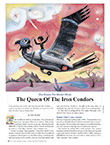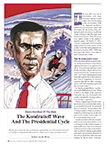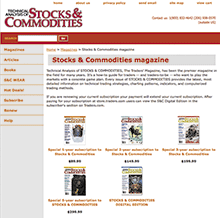LETTERS TO THE EDITOR
September 2012 Letters To The Editor
The editors of S&C invite readers to submit their opinions
and information on subjects relating to technical analysis and this magazine.
This column is our means of communication with our readers. Is there something
you would like to know more (or less) about? Tell us about it. Without a source
of new ideas and subjects coming from our readers, this magazine would not
exist.
Address your correspondence to: Editor, Stocks & Commodities,
4757 California Ave. SW, Seattle, WA 98116-4499, or E-mail to editor@traders.com.
All letters become the property of Technical Analysis, Inc. Letter-writers
must include their full name and address for verification. Letters may
be edited for length or clarity. The opinions expressed in this column do not
necessarily represent those of the magazine. —Editor
IRON CONDORS AND MARGINS
 Editor,
Editor,
I read “The Queen Of The Iron Condors” by John Sarkett in your July 2012 issue about Amy Meissner and her approach to option trading, and I have a few questions.
If I am correct, a trader would need an account with at least $60,000 to trade the iron condor approach discussed in the article.
In Figure 2 in the article, take the example of the January expiration month with a 31.1% gain of the original credit. The gain would be 31.1% of 4, which is 1.2. With a 1.46% gain of maximum risk, the maximum risk would be 100/1.46 *1.2 = $82,000.
Since you open a new position 80–88 days before expiration, you must have at least two months’ open positions, so the margin must be way more than $100,000.
In addition, the Russell 2000 (RUT) out-of-the-money options have a wide bid/ask spread — for instance, 2.8 to 3.45 — which would make it hard to get good executions.
Or do I have it wrong?
Kees Collee
The Netherlands
Amy Meissner replies:
Yes, you would need more than a $60,000 account. I’ll have a maximum of two expiration months on at the same time. I started 2011 with about $275,000 and only traded 20 contracts for the first five months, then 25 contracts after that for the rest of 2011. The bid/ask spread can seem wide for the RUT, but I haven’t had any problems getting filled. I sometimes get the mid price and if not will give them 0.05 to 0.10 cents off the mid.
K-WAVE AND THE PRESIDENTIAL CYCLE
 Editor,
Editor,
Thanks for Koos van der Merwe’s well-written and interesting article in the July 2012 S&C, “The Kondratieff Wave And The Presidential Cycle.”
I would like to seek clarification from him. When he writes, “So the K-wave is telling us ... you should buy stocks on every correction until 2016,” and further, “In Figure 3, the lower chart is suggesting that the bottom shown by ‘F’ will be September 2012….”
Does this imply that Merwe expects a (strong?) correction until September 2012 and then — in alignment with the K-wave — would from then on buy the markets?
Chris Neunkirchner
Author Koos van der Merwe replies:
The Kondratieff wave is calling for growth in the economy until 2016 to 2019. Because the stock market anticipates the economy, at economic bottoms the market goes bullish before the economy recovers. When the economy is due for a correction, the market will delay its correction simply because the public always buys shares at the top. Although the economy may correct in 2016, the stock market may only correct in 2017, or 2019. So be bullish, knowing that the market could uptrend into 2016–19, and consider buying on any and every correction.
As to the correction of 2012: This is the Presidential cycle where, in the fourth year of the cycle, the market has always been bullish. The correction into September? Pure Elliott wave analysis. However, know that my article was written in November 2011 and only published in the July 2012 issue, and the second rule of Elliott wave analysis is that Elliott wave theory is like a signpost in the wilderness, and that new signpost can be just down the road. That is exactly what is happening as I write this in mid-July (July 13–17). These days are very important, especially the 17th. If the DJIA/S&P 500 closes in the green, then the correction into September will likely not happen (based on W.D. Gann’s 7-3-7 cycle theory). However, if the DJIA/S&P 500 closes in the red, then the correction into September (which is usually the quietest month of the year) could very well be in the cards. I hope I am wrong. But the end result of this election cycle wherein President Obama is reelected is definitely still in the cards, according to the Presidential and Kondratieff wave cycle analysis and the bullish move into 2016–19.
I hope this answers your question.
SUBSCRIPTION SIGNUP?
Editor,
We would like to subscribe to your magazine. Can you tell us how to sign up?
Boris Tolmachev
Bulgaria
 You can go to our website at Traders.com, scroll down to the heading “S&C Magazine,” and click on “Subscription Offer” to view the various subscription lengths and rates. Then click on an offer of interest. If you need assistance, you can contact our Circulation Department at circ@traders.com.
You can go to our website at Traders.com, scroll down to the heading “S&C Magazine,” and click on “Subscription Offer” to view the various subscription lengths and rates. Then click on an offer of interest. If you need assistance, you can contact our Circulation Department at circ@traders.com.
Then you can start enjoying all our detailed articles, reviews, and regular features in each issue, whether you choose to read online or in print. Thank you for inquiring.—Editor
ERRATA: SIDESTEPPING THE NEXT CRASH
Editor,
I would like to point out two editing errors that appeared on page 80 in my July 2012 article “Sidestepping The Next Crash” under the subhead “The conditions that need to be met.”
From page 80:
Bear market sell signal condition
The price of the index must cross below both the 50-day SMA and the 100-day SMA and hold beneath both of the SMA lines for three weeks.
This should have read, “The price of the index must cross below both the 50-week SMA and the 100-week SMA…” The reason for this correction is the charts are weekly and so are the moving averages used.
Bear market buy signal condition
The end of the bear market condition is simply when the sell signal stops. So when either of the conditions is not met, the signal stops. This means a buy signal. If the price is below both of the moving averages for three months, as soon as the price crosses up through either one or both of the moving averages, the signal is over. This means a buy.
This should have read, “The end of the bear market condition is simply when the sell signal stops. So when either of the conditions is not met, the signal stops. This means a buy signal. For example, if the price is below both of the moving averages for three months, as soon as the price crosses up through either one or both of the moving averages, the signal is over. This means a buy.”
The reason for this clarification: If the price rises above either the 50-week or 100-week SMA, that signals a buy. This means the bear market signal is over. The reference to three months as it appeared in the published article is erroneous because it was just an example, not part of the rule.
Barry Moore
Originally published in the September 2012 issue of Technical Analysis of Stocks & Commodities magazine. All rights reserved. © Copyright 2012, Technical Analysis, Inc.
Return to
Contents
 Editor,
Editor, Editor,
Editor, You can go to our website at
You can go to our website at